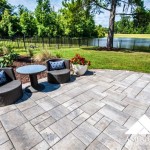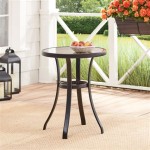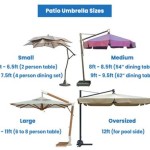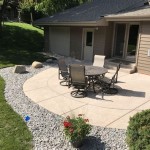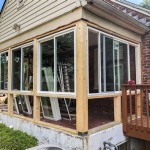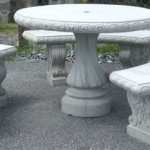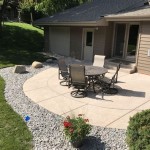Enhance Your Outdoor Living Space With Patio Stair Railings
Patio stair railings are critical components of outdoor living spaces, offering both functional safety and aesthetic value. Selecting and installing appropriate patio stair railings can transform a simple set of steps into an elegant and secure transition between different levels of a yard, deck, or porch. This article explores various aspects of patio stair railings, including materials, design considerations, code compliance, and installation best practices. Understanding these elements ensures a safe and visually appealing outdoor environment.
Material Choices for Patio Stair Railings
Diverse material options exist for patio stair railings, each with its advantages and disadvantages concerning durability, maintenance, cost, and aesthetics. Common choices include wood, metal (aluminum, steel, wrought iron), composite materials, and glass. The selection should align with the overall design scheme of the outdoor space and the specific environmental conditions of the location.
Wood: Wood railings offer a classic and warm aesthetic. Popular wood choices include cedar, redwood, and treated lumber. Cedar and redwood are naturally resistant to decay and insects, making them suitable for outdoor use. Treated lumber is chemically treated to resist rot and insect infestation, offering a more affordable option. Wood railings require regular maintenance, including staining or painting, to protect them from the elements and prevent deterioration. The lifespan of wood railings can be significantly extended with proper care.
Metal: Metal railings provide durability and a sleek, modern look. Aluminum is a lightweight, rust-resistant option that requires minimal maintenance. It is available in various finishes and can be powder-coated to match any color scheme. Steel is stronger than aluminum but is susceptible to rust if not properly coated or galvanized. Wrought iron railings offer a traditional and ornate appearance, but they also require regular maintenance to prevent rust. Metal railings are generally more expensive than wood but offer greater longevity and require less upkeep.
Composite Materials: Composite railings are made from a blend of wood fibers and plastic, offering the look of wood without the maintenance requirements. They are resistant to rot, insects, and fading, making them an ideal choice for areas with harsh weather conditions. Composite railings are available in various colors and styles and require minimal upkeep, typically only needing occasional cleaning. While the initial cost may be higher than wood, the long-term benefits of reduced maintenance make them a cost-effective option.
Glass: Glass railings provide unobstructed views and a contemporary aesthetic. They are typically made from tempered or laminated glass for safety. Glass railings require regular cleaning to maintain their appearance and can be more expensive than other materials. They are a good choice for areas where maximizing views is a priority, but they may not be suitable for all architectural styles.
Design Considerations and Style Options
The design of patio stair railings should complement the architectural style of the building and the overall design of the outdoor space. Factors to consider include the height and style of the railing, the spacing between balusters or pickets, and the overall visual impact. A well-designed railing enhances the aesthetic appeal of the patio and creates a cohesive look.
Railing Height: Building codes typically specify minimum height requirements for stair railings to ensure safety. The required height may vary depending on the location and the specific code requirements. Common heights range from 36 inches to 42 inches. It is essential to consult local building codes to ensure compliance.
Baluster and Picket Spacing: The spacing between balusters or pickets is another critical safety consideration. Building codes typically specify a maximum spacing of 4 inches to prevent small children from squeezing through. The style of balusters or pickets can also impact the overall aesthetic. Options include traditional vertical pickets, horizontal rails, decorative metal designs, and glass panels.
Handrail Design: The handrail is the part of the railing that is grasped for support. It should be comfortable to grip and easy to use. Common handrail materials include wood, metal, and composite materials. The shape and size of the handrail can also impact its usability and aesthetic appeal. Options include rounded handrails, rectangular handrails, and custom-designed handrails.
Style Options: Patio stair railings are available in a wide range of styles to suit different architectural preferences. Traditional styles often feature wood railings with ornate details, such as turned balusters and decorative post caps. Modern styles typically incorporate metal or glass railings with clean lines and minimalist designs. Transitional styles blend elements of both traditional and modern designs.
Selecting the right style involves considering the overall aesthetic of the property and the desired visual impact. A well-chosen railing can enhance the curb appeal of the home and create a welcoming outdoor space.
Code Compliance and Safety Standards
Adhering to building codes and safety standards is paramount when installing patio stair railings. Building codes are designed to ensure the safety of occupants and prevent accidents. Failure to comply with building codes can result in fines, delays, and potentially dangerous conditions. It is important to consult local building codes and obtain any necessary permits before starting the installation process.
International Building Code (IBC): The IBC is a widely adopted model building code that provides comprehensive guidelines for the design and construction of buildings. Many local jurisdictions adopt the IBC or adapt it to meet their specific needs. The IBC includes specific requirements for stair railings, including height, spacing, and load-bearing capacity.
Local Building Codes: Local building codes may have additional requirements or variations from the IBC. It is essential to consult with the local building department to determine the specific code requirements for the project. The building department can also provide information on permit requirements and inspection procedures.
Safety Considerations: In addition to code compliance, it is important to consider other safety factors when installing patio stair railings. These include ensuring that the railing is securely anchored to the stairs and that the handrail is easily accessible and comfortable to grip. The surface of the stairs should be slip-resistant to prevent falls. Adequate lighting should be provided to illuminate the stairs at night.
Regular inspection and maintenance of the railing are also essential for ensuring continued safety. Any damage or deterioration should be promptly repaired to prevent accidents. This includes checking for loose connections, rust, rot, and other signs of wear and tear.
Understanding and adhering to building codes and safety standards is crucial for creating a safe and functional outdoor living space. Professional installation by a qualified contractor can ensure that the railing meets all applicable requirements and provides the necessary level of safety.
Installation Best Practices
Proper installation is essential for the safety and longevity of patio stair railings. Whether opting for a DIY approach or hiring a professional, adhering to best practices ensures a structurally sound and visually appealing result. This involves careful planning, precise measurements, and the use of appropriate tools and materials.
Planning and Preparation: Before starting the installation, it is important to develop a detailed plan that includes measurements, material lists, and a step-by-step procedure. The plan should also address any potential challenges, such as uneven surfaces or existing structures that need to be accommodated. Gather all necessary tools and materials before beginning the work. Ensure you have the appropriate safety gear, including gloves, eye protection, and a dust mask.
Accurate Measurements: Accurate measurements are crucial for ensuring that the railing fits properly and meets code requirements. Measure the height and length of the stairs and the distance between posts. Double-check all measurements to minimize errors. Use a level to ensure that the posts are plumb and the railing is level.
Secure Anchoring: The railing must be securely anchored to the stairs and posts to provide adequate support. Use appropriate fasteners, such as screws or bolts, to attach the railing to the supporting structure. Ensure that the fasteners are compatible with the materials being used. For concrete or masonry surfaces, use anchor bolts or expansion anchors.
Professional Installation: While DIY installation is possible, hiring a professional contractor can ensure that the railing is installed correctly and meets all applicable codes. A professional contractor has the experience, tools, and expertise to handle complex installations and address any unforeseen challenges. Obtaining multiple quotes from qualified contractors is advisable before making a decision.
Regardless of the installation method, thoroughness and attention to detail are key. Regular inspections and maintenance after installation will further ensure the railing’s continued safety and aesthetic appeal. Properly installed patio stair railings not only enhance the beauty of an outdoor space but also provide essential safety and security.
Maintaining Your Patio Stair Railings
Regular maintenance is crucial for preserving the appearance and structural integrity of patio stair railings. Different materials require different maintenance routines, and consistent care will significantly extend the life of the railings. Neglecting maintenance can lead to deterioration, compromising both the aesthetic appeal and the safety of the railing system.
Wood Railing Maintenance: Wood railings are particularly susceptible to weathering and require regular maintenance to prevent rot, decay, and insect infestation. At least once a year, inspect wood railings for signs of damage, such as cracks, splits, or discoloration. Clean the railings with a mild detergent and water to remove dirt and mildew. Apply a sealant, stain, or paint to protect the wood from moisture and UV radiation. Reapply sealant or paint every one to two years, or as needed, to maintain its protective layer. Repair any damage promptly to prevent further deterioration.
Metal Railing Maintenance: Metal railings, while generally more durable than wood, also require periodic maintenance. Inspect metal railings for rust, corrosion, and loose connections. Clean the railings with a mild detergent and water to remove dirt and debris. For aluminum railings, an occasional waxing can help maintain their finish. For steel or wrought iron railings, apply a rust-inhibiting primer and paint to protect against corrosion. Touch up any scratches or chips in the paint to prevent rust from forming. Tighten any loose connections to ensure the stability of the railing.
Composite Railing Maintenance: Composite railings are relatively low-maintenance but still require occasional cleaning. Wash the railings with a mild detergent and water to remove dirt and mildew. A pressure washer can be used for more stubborn stains, but be careful not to damage the surface. Inspect the railings for any signs of damage, such as cracks or warping. Replace any damaged components promptly to maintain the structural integrity of the railing.
Glass Railing Maintenance: Glass railings require regular cleaning to maintain their clarity and appearance. Clean the glass panels with a glass cleaner and a soft cloth to remove dirt, smudges, and fingerprints. Inspect the glass for any cracks or chips. Replace any damaged glass panels immediately to prevent accidents. Check the hardware and connections for any signs of looseness or corrosion. Tighten or replace any damaged hardware as needed.
By implementing a consistent maintenance routine, homeowners can ensure that their patio stair railings remain safe, functional, and visually appealing for years to come. Proper maintenance not only extends the life of the railing but also enhances the overall enjoyment of the outdoor living space.

Outdoor Stair Railing Ideas To Inspire You Timbertech

Outdoor Stair Railing Ideas To Inspire You Timbertech

Enhance Your Outdoor Living Space Premium Aluminum Balcony Railing China Glass Made In Com

Outdoor Stair Railing Ideas To Inspire You Timbertech

Deck Railing Ideas Complete Your Outdoor Space Timbertech

Outdoor Stair Railing Ideas To Inspire You Timbertech

Outdoor Stair Railing Ideas To Inspire You Timbertech

6 Ways To Upgrade Your Deck Or Patio On Any Budget Agsstainless Com

Enhance Your Outdoor Living Space Premium Aluminum Balcony Railing China Glass Made In Com

14 Deck Railing Ideas To Upgrade Your Outdoor Space Bob Vila
Related Posts

